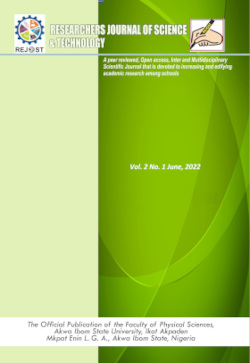Analysis of ionospheric response to Earthquake using GPS data: a case study of Chignik, North America and Southern-Sandwich, South America Earthquakes
Keywords:
Earthquake, GPS-TEC, Seismogenic, Ionospheric, anomaliesAbstract
In this study, GPS-derived total electron content (TEC) data were utilized to monitor ionospheric behaviour 20 days before and 5days after two significant earthquakes that occurred in Chignik, North America and Southern-Sandwich, South America on 10th November 2021 and 8th December 2021 respectively. Data were collected from GPS stations within the seismogenic zone. The sunspot number (SSN) and F10.7 indices were used to track solar activity during the events, while the planetary geomagnetic activity index (kp) and disturbance storm-time (Dst) indices were used to check geomagnetic activity. Results from the analysis revealed that TEC data contain both negative and positive ionospheric anomalies during the investigative period using a statistical analysis technique that involved moving median. Geomagnetic and solar indices indicated relative stillness during 88% of the anomalous days isolated for the earthquakes, hence anomalies were considered seismogenic. The result further suggests that a significantamount of disturbances is caused by seismogenic processes. As earthquake-induced anomalies were found within 20 days of the studied cases, it was also shown by the discovery of earthquake-induced TEC anomalies through temporal analysis that ionospheric fluctuations are crucial for earthquake forecasting. Therefore, this study suggests that there could be a connection between TEC anomalies in the ionospheric space and the occurrence of significant earthquakes. Thus, it is advised that TEC monitoring be seriously taken into account for short-term earthquake event forecasting, particularly in regions with unreliable seismic measurements.
References
Akhoondzadeh, M. (2013) Genetic algorithm for TEC seismo-ionospheric anomalies detection around the time of the Solomon
(Mw = 8.0) earthquake. 52, (4), 581-590
Akhoondzadeh, M. (2019). Seismo-magnetic Field Anomalies Detection using Swarm Satellites (Alpha, Bravo and Charlie). International Archives of the Photogrammetry, Remote Sensing and Spatial Information Sciences - ISPRS Archives. https://doi.org/10.5194/isprsarchives-XLII-4-W18-45-2019.
Akhoondzadeh, M., De Santis, A., Marchetti, D., Piscini, A., & Cianchini, G. (2018).Multi precursors analysis associated with the powerful Ecuador (M W = 7.8) earthquake of 16 April 2016 using Swarm satellites data in conjunction with other multi-platform satellite and
ground data. Advances in Space Research. https://doi.org/10.1016/j.asr. 2017.07.014.
Baselga, S. (2020). A combined estimator using TEC and b-value for large earthquake prediction. Acta Geodaetica et Geophysica. https://doi.org/10.1007/ s40328-019-00281-5.
Bolaji, O. S., Fashae, J. B., Adebiyi, S. J., Owolabi, C., Adebesin, B. O., Kaka, R. O., ... Younas, A. W. (2021). Storm Time Effects on Latitudinal Distribution of Ionospheric TEC in the American and Asian-Australian Sectors: August 25–26, 2018 Geomagnetic Storm. Journal of Geophysical Research: Space Physics, 126 (8). https://doi.org/10.1029/2020JA029068.
Currie, J. L., & Waters, C. L. (2014). On the use of Geomagnetic indices and ULF waves for earthquake precursor signatures. Journal of Geophysical Research A: Space Physics. https:// doi.org/10.1002/2013JA019530.
Dobrovolsky, I. P., Zubkov, S. I., & Miachkin, V. I., (1979). Estimation of the size of earthquake 335 preparation zones. Pure and applied geophysics, 117(5), 1025-1044.
Durmaz, M., & Karslioglu, M. O. (2014). Regional vertical total electron content (VTEC) modeling together with satellite and receiver differential code biases (DCBs) using semi-parametric multivariate adaptive regression Bsplines (SP-BMARS). Journal of Geodesy, 89 (4), 347–360. https://doi: 10.1007/s00190-014-0779-8.
Hafeez, A., Shah, M., Ehsan, M., Jamjareegulgarn, P., Ahmed, J. … Tariq, M.A. (2021). Possible Atmosphere and Ionospheric Anomalies
of the 2019 Pakistan Earthquake Using Statistical and Machine Learning Procedures on MODIS LST, GPS TEC, and GIM TEC. Journal of Selected Topics in Applied Earth Observations and Remote Sensing. 14, 11126–11133, doi:10.1109/JSTARS.2021.3119382
He, L, and Heki, K. (2017). Ionospheric anomalies immediately before Mw 7.0-8.0 earthquakes. Journal of Geophysical Research - Space Physics, 122, 8659-8678.
Heki, K., & Enomoto, Y. (2013). Preseismicionospheric electron enhancements revisited. Journal of Geophysical Research: Space Physics.
https://doi.org/10.1002/jgra.50578.
Ibanga, J. I., Akpan, A. E., George, N. J., Ekanem, A. M., & George, A. M. (2018). Unusual ionospheric variations before the strong Auckland Islands, New Zealand earthquake of 30th September, 2007. NRIAG Journal of Astronomy and Geophysics. https://doi.org/10.1016/j.nrjag.2017.12.007.
Klobuchar, J. A. (1987). Ionospheric TimeDelay Algorithm for Single-Frequency GPS Users. IEEE Transactions on Aerospace and Electronic Systems. https://doi.org/10.1109/TAES.1987.310829.
Komjathy, A., Galvan, D.A., Stephens, P. (2012). Detecting ionospheric TEC perturbations caused by natural hazards using a global network of GPS receivers: The Tohoku case study. Earth Planet Sp 64, 24. https://doi.org/10.5047/eps.2012.08.003
Liu, J. Y., Le, H., Chen, Y. I., Chen, C. H., Liu, L., Wan, W., Su, Y. Z., Sun, Y. Y., Lin, C. H., & Chen, M. Q. (2011). Observations and simulations of
seismoionospheric GPS total electron content anomalies before the 12 January 2010 M7 Haiti earthquake. Journal of Geophysical Research: Space Physics. https://doi.org/10.1029/2010JA015704.
Liu, J.Y., Chen, Y., Chen, C.H., Liu, C., Chen, C., Nishihashi, M., Li, J., Xia, Y., Oyama, K. and Hattori, K., (2009). Seismoionospheric GPS total electron content anomalies observed before the 12 May 2008 w7. 9 Wenchuan earthquake. Journal of Geophysical Research - Space Physics, 114.
Mannucci, A. J., Wilson, B. D., & Edwards, C. D. (1993). A New Method for Monitoring the Earth’s Ionospheric Total Electron Content Using the GPS Global Network. In ION GPS 1993 Proceedings. 1323–1332.
Mendillo, M. (2006). Storms in the ionosphere: Patterns and processes for total electron content. In Reviews of Geophysics. https://doi.org/10.1029/2005RG000193.
Pulinets, S. A., Kotsarenko, A. N., Ciraolo, L., Pulinets, I. A (2007) Special case of ionospheric dat-to-day variability
associated with earthquake preparation. 39, (5), 970-977
Schaer, S. (1999) Mapping and predicting the Earth's ionosphere using the global positioning system. Ph.D. thesis, Ph.D. dissertation. University of Bern, Bern.
Shah, M., Aibar, A.C., Tariq, M.A., Ahmed, J., Ahmed, A., 2020. Possible ionosphere and atmosphere precursory analysis related to Mw& 6.0
earthquakes in Japan. Remote Sens. Environ. 239, 111620.
Shah, M., Tariq, M. A., Ahmad, J., Naqvi, N. A., & Jin, S. (2019). Seismoionospheric anomalies before the 2007 M7.7 Chile earthquake from GPS TEC and DEMETER. Journal of Geodynamics. https://doi.org/10.1016/j.jog.2019.05.004.
Shi, K., Liu, X., Guo, J., Liu, L., You, X., & Wang, F. (2019).Pre-Earthquake and coseismic Ionosphere disturbances of the Mw 6.6 Lushan Earthquake on 20 April 2013 Monitored by CMONOC. Atmosphere. https://doi.org/10.3390/ATMOS10040216.
Tariq, M. A., Shah, M., Li, Z., Wang, N., Shah, M. A., Iqbal, T., & Liu, L. (2021). Lithosphere ionosphere coupling associated with three earthquakes in Pakistan from GPS and GIM TEC. Journal of Geodynamics. https://doi.org/10.1016/j.jog.2021.101860.
Thomas, J. E., (2021). LithosphereAtmosphere-Ionosphere Coupling Processes for Pre-, Co-, and Post Earthquakes: A case study of Northern
Mariana, U.S.A. Earthquake of 31st October, 2007. Researchers Journal of Science and Technology. 1, 37-46.
Ulukavak, M., Yalçınkaya, M., Kayıkçı, E.T., ¨Oztürk, S., Kandemir, R., and Karsli, H., (2020). Analysis of ionospheric TEC anomalies for global earthquakes during 2000-2019 with respect to earthquake magnitude (Mw≥ 6.0). Journal of Geodynamics. 135, 101721.

Downloads
Published
How to Cite
Issue
Section
Categories
License

This work is licensed under a Creative Commons Attribution-NonCommercial-NoDerivatives 4.0 International License.




